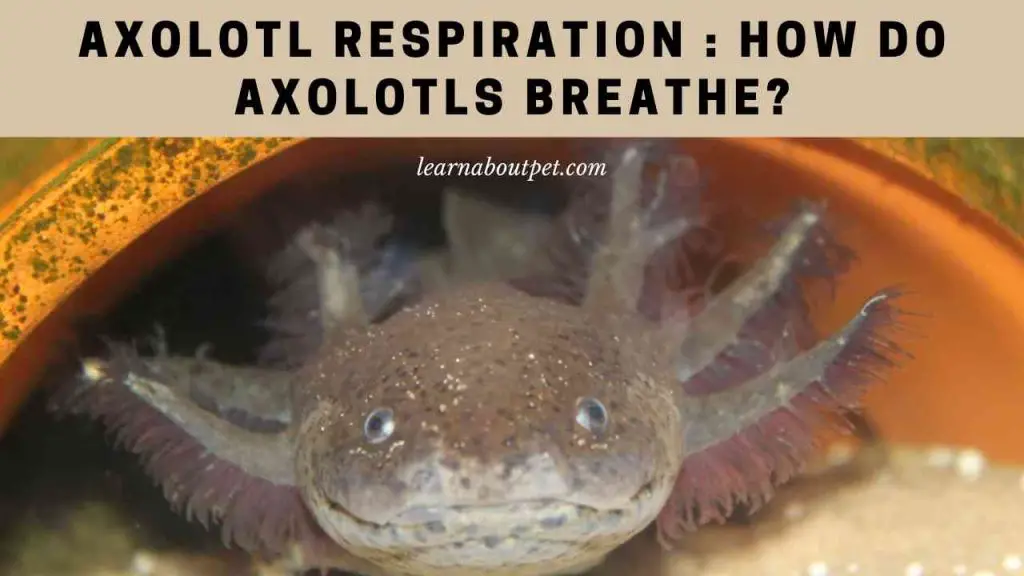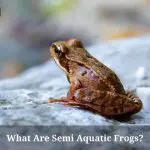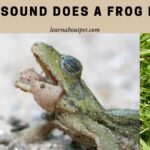The axolotl, or Mexican walking fish, is one of the world’s most unique animals. The axolotl is famous for its ability to regenerate limbs, organs and other body parts. Another fascinating fact about an axolotl is that it has the capability to repair brain damage.
What about when it comes to axolotl respiration, can axolotls breathe air? Although axolotls can breathe air, they need to be submerged in water to be able to do so. Furthermore, axolotls are aquatic, meaning they live in water for their entire lives, and never develop into land-dwelling adults like frogs or salamanders do. Because axolotls don’t live on land, they don’t need to develop lungs.

Can Axolotls Breathe Air?
Yes, inhalation is a vital part of axolotl respiration. That said, although axolotls can breathe air, they prefer to spend most of their time underwater. They can climb out of their tanks and walk on land for a short amount of time, as long as their skin stays wet.
If you’ve ever been curious about these cute creatures, here are some things you probably didn’t know about axolotls:
Axolotls can regenerate limbs and other body parts faster than most other animals. They have the incredible ability to regenerate lost limbs, lower jaws and even damaged portions of their brains and spinal cords.
They also have the ability to do this as a result of the large number of stem cells in their bodies. These stem cells can divide into a variety of other cells. Axolotls can also regrow parts of their hearts.
Do Axolotls Breathe Air?
Axolotls are amphibians, meaning that they have gills and can extract oxygen from water. However, when it comes to axolotl respiration, axolotls can breathe air if they need to. This is why they are mostly found near the water surface, with their heads protruding.
Moreover, axolotls live in permanent aquatic environments and have no lungs with which to breathe air. They use three primary mechanisms to obtain oxygen. These mechanisms are responsible for axolotl respiration.
How Do Axolotls Breathe?
Like all amphibians, axolotl respiration largely depends on an axolotl’s gills. The axolotl’s external gills are bright red and feathery in appearance. Similar to fish, they absorb oxygen from the water around them, but unlike fish, they don’t have to swim all the time to do it.
They also have lungs like humans do, but they don’t use them very often. They’ll occasionally come up for a breath of air if they need to, but mostly they just stay underwater. So, whenever the question of how do axolotls breathe pops up, you now know what to say.
Do Axolotls Breathe Air Or Water?
This is one question that always pops up when it comes to the how do axolotls breathe subject. Well, the answer is simple. Like all amphibians, axolotls have lungs and breathe air.
However, they have the option to absorb oxygen through their skin as well. As a result, axolotls can be seen floating at the bottom of their tank, or sitting on a rock with their heads out of water as they absorb oxygen.
Talking of whether axolotls breathe air or water, what about when it comes to axolotl respiration, can axolotl respiration take place in water? Yes, axolotls can breathe in water through their gills or skin, or outside water through their lungs.
How Often Do Axolotls Breathe Air?
Axolotls breathe through three different systems, their skin, gills and lungs. They will breathe air when they have to, but prefer to stay underwater if possible. There is no need for them to come out of water for a breath because they can absorb oxygen from the water through their gills.
Can Axolotls Breathe Out Of Water?
Axolotls live underwater and do not have lungs, instead they breathe through their gills. They can, however, come to the surface to gulp air when oxygen levels are low in their water. Talking of whether axolotls can breathe out of water, what about when it comes to axolotl respiration, how do axolotls breathe?
Axolotls breathe through external gills located on each side of their head behind the eyes. The gills extend out from the body and look like feathery feathers. The axolotl’s gills are made up of folds that allow oxygen-rich water to pass through them.
Oxygen circulates throughout the blood vessels within the gill filaments, allowing the creature to absorb it into its bloodstream.
Do Axolotls Need To Breathe Air?
Yes, axolotls need to breathe air. However, axolotls can also simply absorb oxygen through their skin. You’ll usually see them at the surface just like any fish would be if they were low on oxygen.
Talking about whether axolotls need to breathe air, what about when it comes to the axolotl respiration process, or better yet, how do axolotls breathe? Axolotls can breathe through their skin and by using their feathery gills. The air they breathe contains oxygen which is used in the process of respiration.
Axolotls, being amphibians, can use the same organs for breathing as other amphibians do, which also includes lungs.
How Long Can Axolotls Breathe Out Of Water?
Axolotls breathe underwater through gills, so they need to stay in water to breathe. As they grow larger (around 1 year old), axolotls may occasionally leave their tank or bowl and explore the area around it. They do this by crawling like a snake.
Talking of how long axolotls can breathe outside water, what about when it comes to axolotl respiration? The axolotl breathes through its skin, which is moist and rich in blood vessels. This moist skin can absorb oxygen from the water, which allows the animal to stay underwater for long periods of time.
The axolotl can also breathe through its lungs, more so when it comes to the surface.

How Many Ways Can Axolotls Breathe?
The axolotl is a type of salamander classified as an amphibian. Like all amphibians, axolotl respiration takes place outside water through an axolotl’s lungs or from water through its skin. The axolotl’s gills also help it breathe.
It’s no wonder the axolotl can breathe in so many ways. It uses all three methods at once! Furthermore, an axolotl’s skin has lots of ridges, which gives it more surface area to absorb oxygen from the water. It breathes air using its lungs and breathes water using its gills.
The axolotl doesn’t have to worry about getting enough oxygen because it can use several different parts of its body to absorb oxygen from both water and air.
Axolotl Skin Breathing
Intriguingly, axolotl respiration can take place through an axolotl’s skin. The skin is loaded with blood vessels and capillaries, which allow the axolotl to absorb oxygen directly from the water. Although they can use their lungs for respiration, axolotls often go for extended periods of time without using them at all.
While the ability to breathe through their skin is certainly useful, it does not come without a cost. Axolotls are highly susceptible to infections, particularly those caused by bacteria and fungi.
Axolotls are also neotenic (a fancy word that means they retain larval characteristics throughout life). In other words, axolotls never metamorphose into adults like most salamanders do.
Although this may seem like a strange trait at first glance, there are actually quite a few advantages to being neotenic. For example, because they never lose the gills, tails and fins of their larval selves, they retain a number of features that make them perfectly suited for life in the subterranean waterways of Xochimilco.
Axolotl Gills Breathing
Although there is a widespread notion that axolotls are fish, that is actually not the case. Axolotls are not fish but they are amphibians, meaning they can live on land but prefer to be underwater.
Axolotls breathe like fish using gills instead of lungs. They have several adaptations that let them live in water, including their gills, which look like feathery fronds on their head, not to mention their webbed feet.
Axolotl Buccal Respiration
There are three major ways axolotl respiration can occur. The first is buccal respiration, which is a form of mouth-breathing. The second is cutaneous respiration, where the blood vessels in the skin absorb oxygen from the water.
Thirdly, axolotls can use their gills to breathe underwater. The axolotl’s heart is located on the right side of its body and has three chambers — two atria and one ventricle.
Axolotl Lung Breathing
The axolotl also develops a quite complex lung, quite unlike the gills of fish. The axolotl’s lung is divided into chambers and has a lining that secretes mucus, which helps to protect the lungs from tiny particles of dust. Simple tracheal tubes branch off the main air passage and take the air directly to all parts of the body.
These tubes are called parabronchi, and for a long time it was believed that these were primitive versions of true lungs. However, recent research has shown that they act like gills in amphibians, with blood flowing around them so that oxygen can diffuse out into the bloodstream.
Because they have both gills and lungs, axolotls are able to breed on land; but they much prefer to breed in water because there is more oxygen available for their offspring.
Axolotl Oxygenation Guide
Axolotls are fascinating and beautiful creatures, but they require very specific care to thrive. Your axolotl respiration is the most important aspect of your axolotl life and well-being. This is considering that this is what literally keeps this little fella alive.
It is therefore essential to provide care and enough oxygen for your axolotl to survive. This guide will discuss the importance of oxygenation and how to provide the best environment for your axolotl.
Axolotls need a lot of oxygen in their water because they cannot breathe air like humans or amphibians, such as frogs and salamanders. How much oxygen they need depends on several factors including: how many axolotls you have in the tank, how much surface area your tank has, whether or not it is heated and more.
Final Verdict – Axolotl Respiration – How Do Axolotls Breathe
In conclusion, what can we say about the axolotl respiration-how do axolotls breathe topic? Axolotls have three different respiratory systems. These include the skin, lungs and gills.

While they do have the ability to breathe air through their lungs, this is more of an alternative to their main method of breathing. Axolotls can absorb oxygen directly from the water through their skin and gills.
They have a very large surface area of skin which helps them to absorb a lot of oxygen. Axolotls also have external gills that are covered by feathery filaments called “gill rakes”.
These gill rakes are vital to axolotl respiration since they help the axolotl to filter oxygen out of the water as it passes over their gills. Axolotls do not have internal gills like fish, and they are not able to breathe without water.
Moreover, axolotls have numerous capillary beds throughout their bodies. These vessels help them to absorb oxygen from the water. Their circulatory system is also very efficient at transporting this oxygen to other parts of their body where it is needed.
As a pet lover, make sure to learn about pet more and give your pet axolotl a good and comfortable life!

Welcome to Learn About Pet. My name is Rajkumar Ravichandran and I love all pets, travel, and amazing food. I write about my passion and personal experience caring for multiple pets in this blog! ❤️
Post Disclaimer
DISCLAIMER: THIS BLOG OR WEBSITE, "Learn About Pet", DOES NOT PROVIDE YOU WITH MEDICAL ADVICE AND IS NOT A SUBSTITUTE FOR MEDICAL ADVICE. ALWAYS GET IN TOUCH WITH YOUR PERSONAL VETERINARIAN AND USE INFORMATION HERE AS GENERAL ADVICE.
The information, including but not limited to, text, graphics, images and other material contained on this website are for informational purposes only. No material on this site is intended to be a substitute for professional veterinary advice, food recommendation, diagnosis, or treatment. Always seek the advice of your veterinarian or other qualified health care provider with any questions you may have regarding a medical condition or for pet food related questions.







